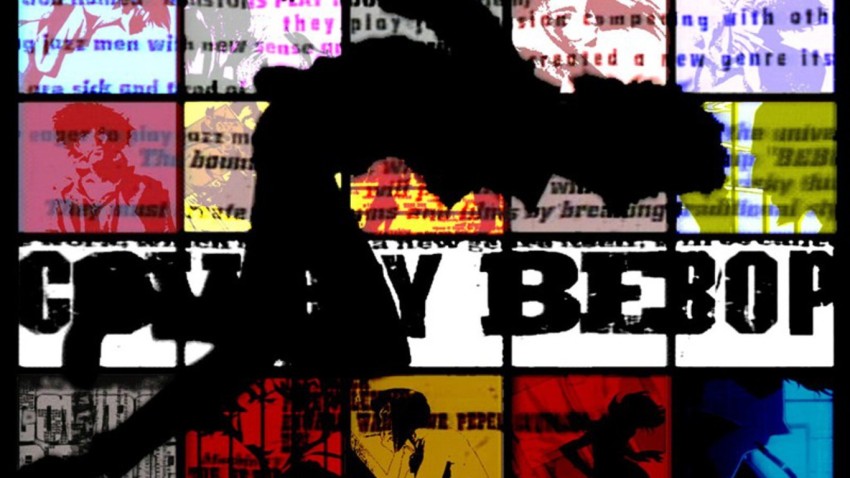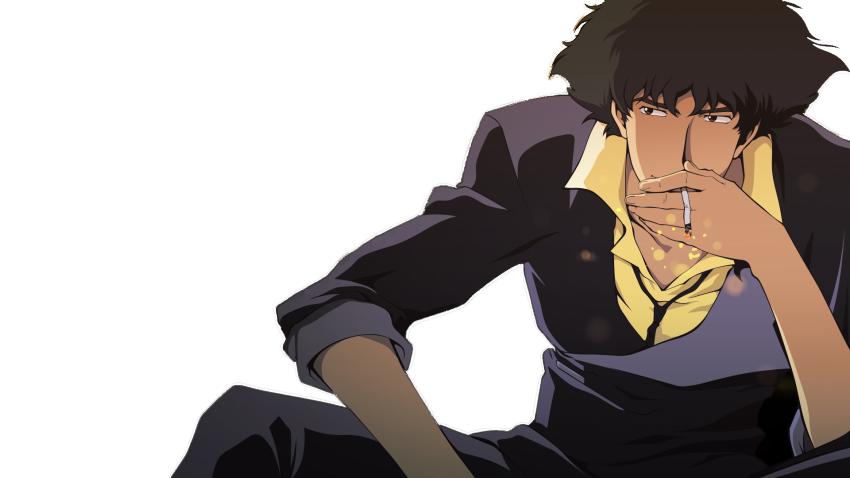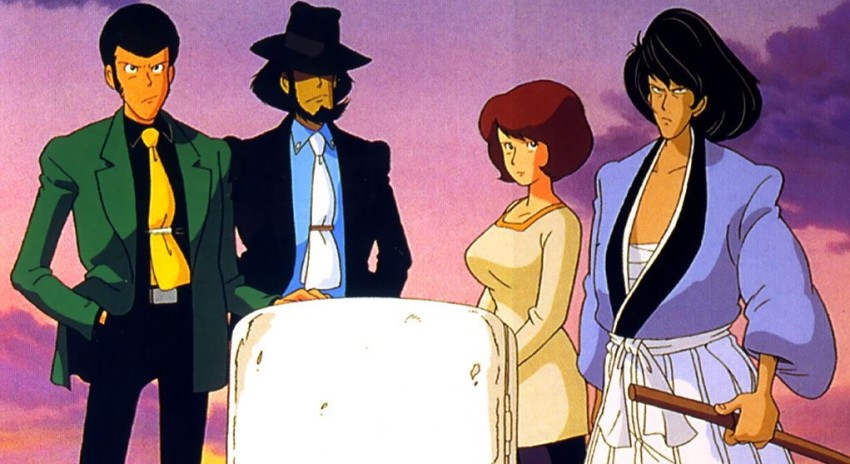Cowboy Bebop
November 18, 2019 · 0 comments
By Andrew Osmond.
 Cowboy Bebop turns 21 this year. For those who’ve never seen it, the 26-part series chronicles the misadventures of a cluster of spacefaring bounty hunters, in a future that’s lurid, farcical and tragic by turns. It’s somewhere between Blade Runner, Futurama and Kill Bill (predating the last two). It has an iconic hero – Spike Spiegel, an elegant thin-man gumshoe who seems to spend half his life sleeping and the other half dealing violence like an artist. The series has kung fu, specifically the freestyle Bruce Lee variant called Jeet Kune Do. It has shoot-out bloodbaths. It has the drifting ennui of freelancers subsisting on noodles and cold showers. It has a Welsh corgi. It oozes cool like a wardrobe of James Bond tuxedoes.
Cowboy Bebop turns 21 this year. For those who’ve never seen it, the 26-part series chronicles the misadventures of a cluster of spacefaring bounty hunters, in a future that’s lurid, farcical and tragic by turns. It’s somewhere between Blade Runner, Futurama and Kill Bill (predating the last two). It has an iconic hero – Spike Spiegel, an elegant thin-man gumshoe who seems to spend half his life sleeping and the other half dealing violence like an artist. The series has kung fu, specifically the freestyle Bruce Lee variant called Jeet Kune Do. It has shoot-out bloodbaths. It has the drifting ennui of freelancers subsisting on noodles and cold showers. It has a Welsh corgi. It oozes cool like a wardrobe of James Bond tuxedoes.
The series was first broadcast in Japan from April to June 1998, albeit in a truncated run on TV Tokyo when just twelve episodes were shown. This censored broadcast was a strange turning point in anime history. It left Japanese viewers in a similar position to British fans watching the 4Kids edit of One Piece, or their predecessors watching Battle of the Planets. Deemed unsuitable for terrestrial viewing, the uncut Bebop migrated; the full 26-part series played in a late night slot on the satellite channel WOWOW, setting an industrial precedent. According to Anime: A History by Jonathan Clements, the uncut Bebop’s success turned “late night television into a dumping ground for hundreds of new, relatively cheap ‘adult’ shows.” (An example is Satoshi Kon’s macabre Paranoia Agent, broadcast by WOWOW six years after it saved Bebop.)
 Before Cowboy Bebop, anime – TV anime at least, removed from those naughty things happening direct-to-video – was still aimed largely at children. Of course, far more was permitted in these shows than in their British or US counterparts. The ‘kiddie’ anime included Gundam, Fist of the North Star and Revolutionary Girl Utena. But by the 1990s, animators were pushing the boundaries. Neon Genesis Evangelion (broadcast primetime in 1995-6) angered broadcasters with its scenes of violence and consenting adult sex. By taking much of TV anime into late-night slots, Bebop led the industry down a similar path to superhero comics in America. It burned away the remnants of the medium’s censorious past (remember the Comics Code), but it also made the genre into a fan-oriented cult.
Before Cowboy Bebop, anime – TV anime at least, removed from those naughty things happening direct-to-video – was still aimed largely at children. Of course, far more was permitted in these shows than in their British or US counterparts. The ‘kiddie’ anime included Gundam, Fist of the North Star and Revolutionary Girl Utena. But by the 1990s, animators were pushing the boundaries. Neon Genesis Evangelion (broadcast primetime in 1995-6) angered broadcasters with its scenes of violence and consenting adult sex. By taking much of TV anime into late-night slots, Bebop led the industry down a similar path to superhero comics in America. It burned away the remnants of the medium’s censorious past (remember the Comics Code), but it also made the genre into a fan-oriented cult.
Ironically, though, Cowboy Bebop’s importance outside Japan was to make anime less cultish. Again, it was shown in late-night slots, as part of the first 2001 line-up in the “Adult Swim” block on America’s Cartoon Network. This broadcast had some censorship of its own, both for violence and for images considered too close to the 9/11 attacks which occurred while the series was running; for example, the farcical “Cowboy Funk” episode was skipped due to its images of explosions in a tall building.
Cowboy Bebop also reached British TV on the related CNX channel. The spin-off movie had a limited cinema release in Britain in 2003. Whether on the big or small screen, Bebop sold itself, a cool, stylish, exciting, ironic, adult work. It transcended anime as many people understood it: Pokemon, Dragon Ball Z, the spectacular but narratively confused Akira.
I once interviewed Kevin Eastman, co-creator of the Teenage Mutant Ninja Turtles comic. Like many people, he saw some of the early anime imports and then lost interest. “I fell out of it for a bit, until I went through a comic store and saw the first US collection of Cowboy Bebop. I loved the graphics and reconnected with that whole world.” Or as a contemporary Bebop review on the teevee.org blog put it, “It’s an anime that even anime haters can enjoy.”
 Bebop’s director, Shinichiro Watanabe, is widely regarded as one of the strongest voices in anime, yet Bebop is no auteur work; rather, it’s immensely collaborative. The best-known of Watanabe’s fellows inspired one of Bebop’s crew. The celebrated musician Yoko Kanno was the model for the flappy-limbed, manically daffy hacker Edward. Kanno was herself responsible for some of the series’ most celebrated cinematic flourishes.
Bebop’s director, Shinichiro Watanabe, is widely regarded as one of the strongest voices in anime, yet Bebop is no auteur work; rather, it’s immensely collaborative. The best-known of Watanabe’s fellows inspired one of Bebop’s crew. The celebrated musician Yoko Kanno was the model for the flappy-limbed, manically daffy hacker Edward. Kanno was herself responsible for some of the series’ most celebrated cinematic flourishes.
For example, in one episode a character falls endlessly from the smashed rose window of a cathedral, flashing through memories of a backstory we never see in full, accompanied by an exquisite made-up hymn in a made-up language, “Green Bird.” The song looks forward to Kanno’s later journeys into transcendence, such as the hymn-inflected “Inner Universe” which starts Ghost in the Shell Stand Alone Complex. The Bebop sequence is often compared to John Woo, but may equally look back to the shattered last montage in the horror classic Don’t Look Now.
Bebop’s writing is largely by another woman, Keiko Nobumoto (Macross Plus, Tokyo Godfathers), and is delivered by voice-actors of the stature of Koichi Yamadera (Spike) and Megumi Hayashibara (Faye). They bring noiresque Hollywood glamour to the character’s pathetic break-ups, their self-immolating pyres of hope and happiness. The dialogue is also dryly funny, as when a character is woken from a decades-long cryogenic sleep into Bebop’s future world. She is asked to identify the objects around her. She has no trouble naming the TV, the hot water pot and the mobile phone; only her frame of reference is half-a-century out of date and the objects are actually a washing machine, a facewasher and a ‘smart’ thermometer.
 It could be a gag from Futurama, which also has a ‘sleeper wakes’ premise. Instead, it’s part of the Bebop’s most heartbreaking plotline, and a reminder of the deep sadness underlying the show. There’s a linked gag about the war between the Betamax and VHS video formats; you’ll either be confused or you’ll burst into nostalgic tears for your lost geek time.
It could be a gag from Futurama, which also has a ‘sleeper wakes’ premise. Instead, it’s part of the Bebop’s most heartbreaking plotline, and a reminder of the deep sadness underlying the show. There’s a linked gag about the war between the Betamax and VHS video formats; you’ll either be confused or you’ll burst into nostalgic tears for your lost geek time.
Then there’s the visual presentation, making Cowboy Bebop a rare anime that hardly dates as the decades past. Its lack of CG only raises its integrity. Over seventy key animators are listed on Cowboy Bebop’s page on Anime News Network; they were probably drawn to the show by a policy at the Sunrise studio of not pushing staff to the insane levels of overwork that typify anime. Called the “Happiness Project,” the policy was initiated by a producer called Masahiko Minami, who then left Sunrise to co-found Studio Bones. (Bones would later make the Watanabe-conceived Space Dandy).
Among Bebop’s animators, Yutaka Nakamura, who worked on twelve TV episodes and the film, is especially celebrated; you can see a montage of his Bebop work here and a broader tribute here. The brilliant, mutually complementing character designs were by Toshihiro Kawamoto, whose work more recently graced Blood Blockade Battlefront. Just consider what an odd-shaped couple the bulky Jet and the gracile Spike make in Bebop. The show’s mecha were provided by Kimitoshi Yamane (Gundam Seed), with craft that look wondrous seen from space, in wry contrast to their dark and dingy interiors, which are played for more gently rueful human humour than other downmarket space comedies like Dark Star and Red Dwarf.
For Bebop is comedy as well as tragedy. If you’ve not watched it for a while, you might be surprised how many of the episodes are played for outright laughs. Of course, there’s the fondly-remembered Alien spoof, with its multipurpose flamethrowers and sublimely silly punchline. There’s the Blaxploitation-stoner episode, with gags about the original coffin-dragging Django and a Pam Grier lookalike. There are sight gags, such as a badly-parked spacecraft blocking traffic, and the man in a teddy suit chased by the spacecraft and a cowboy on horseback. At least one episode steers towards a funny feel-good ending before suddenly switching to tragedy, reflecting the show as a whole.
Anime always shifts from comic to serious, but Bebop takes this to extremes, in ways seldom seen on live-action Western TV since the vintage series anthologies (Alfred Hitchcock Presents) or near-anthology dramas (Route 66) which Bebop sometimes echoes. From an anime angle, you could see Bebop as a remake of the madcap Lupin the Third, but with ennui and tragedy underlying the silly chases. Ironically Koichi Yamadera, who voiced Spike in Bebop, now voices the stuffy Inspector Zenigata in the Lupin franchise.
 Watanabe has said the anime which most inspired him was indeed Lupin, specifically the first TV version in 1971 with violence and a dark edge, anticipating 2012’s The Woman Called Fujiko Mine. In Bebop, one of the nastiest villains wears Lupin’s old-school green jacket; is this a throwaway gag for the fans, or a deep comment to unpack? Bebop demands repeat viewing to trace the motifs and strands. While the overt ‘arcs’ account for just a few of the 26 episodes, there’s so much else to notice. Two of the most obvious motifs are sleep and dreaming, which become central to the finale, and then trace ‘backwards’ to form a prominent part of the feature film, which was made later but set earlier.
Watanabe has said the anime which most inspired him was indeed Lupin, specifically the first TV version in 1971 with violence and a dark edge, anticipating 2012’s The Woman Called Fujiko Mine. In Bebop, one of the nastiest villains wears Lupin’s old-school green jacket; is this a throwaway gag for the fans, or a deep comment to unpack? Bebop demands repeat viewing to trace the motifs and strands. While the overt ‘arcs’ account for just a few of the 26 episodes, there’s so much else to notice. Two of the most obvious motifs are sleep and dreaming, which become central to the finale, and then trace ‘backwards’ to form a prominent part of the feature film, which was made later but set earlier.
Jacob Chapman’s review of Cowboy Bebop on Anime News Network offers an excellent account of the characters’ Pinteresque broken relationships. Susan Napier (Anime from Akira to Howl’s Moving Castle) focuses on the masculinity of both the men and women characters; she notes that Spike alludes in a monologue to Ernest Hemingway’s The Snows of Kilimanjaro, a classic story of male doom and dreaming.
But perhaps the main subject of fan discussion is whether there will ever be any more Bebop. The zeitgeist hasn’t passed it by; arguably the director closest to Bebop’s genre-gumbo pop-sensibility is Quentin Tarantino, who’s still going strong with The Hateful Eight. As with Akira, a live-action Bebop remake has kicked around Development Hell for years. Keanu Reeves was long attached as a possible Spike but has since said, “Cowboy Bebop does not look like it is going to happen with me in it.” Of course, it should be happening with John Cho in it, although his recent on-set injury has put production back by several months.
Watanabe and many of his brilliant Bebop partners remain active in anime, and often intersect on projects (for example, Watanabe, Yoko Kanno, Keiko Nobumoto and Yutaka Nakamura were involved in Space Dandy). For readers wanting Watanabe’s comments on Bebop’s ending and the prospect of a sequel, see the spoiler-heavy videos here (4-15 and 7-20) and here (6-20). Spoilers apart, there are obvious ways the Bebop universe could continue, but Watanabe’s attitude is that he would only do so if he could improve on the original. Unfortunately in Bebop’s case, that would be hard.
Andrew Osmond is the author of 100 Animated Feature Films.
Cowboy Bebop is released in the UK by Anime Limited and is now streaming on Channel 4’s All4 service!
anime, Bandai, Bones, Cowboy Bebop, Japan, Keiko Nobumoto, Masahiko Minami, Sunrise, Toshihiro Kawamoto, Yoko Kanno
Leave a Reply